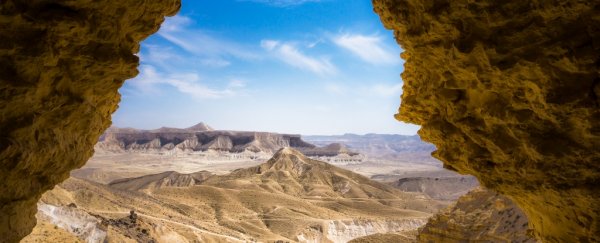The Negev desert that sprawls across Israel is one of the driest places on Earth, but deep below its surface is a different story. Held in the sandstone deep underground is a reservoir of fossil water that lay undisturbed for hundreds of thousands of years.
Researchers know this water is old, because it can't have been replenished by any recent rainfall. There's barely enough every year to moisten the ground - just a few inches at most.
Therefore the aquifer must be a product of the region's ancient history, a testament to the dramatic changes wrought on the landscape over millennia.
But where did the water come from? The aquifer forms part of the Nubian Sandstone Aquifer System, the bulk of which lies under the eastern Sahara. Is it all connected? How much water is under the Negev desert, and what's it doing?
To find out, a team at the Ben-Gurion University of the Negev turned to an unusual technique developed at the US Argonne National Laboratory: analysis of a rare radioactive isotope of the gaseous element krypton.
With this, they managed to trace the origins of the groundwater to two events - one just under 38,000 years ago, and the other around 360,000 years ago.
Here's how it works. After collecting water from over 20 wells in the desert, the researchers separated out the krypton gas in their samples.
This is then subjected to Argonne's technique, called Atom Trap Trace Analysis. This can pick out the rare radioisotope 81Kr from the krypton gas, and date it to a range between around 40,000 and 1.5 million years.
In addition, they looked for deuterium, a "heavy" isotope of hydrogen that can be produced by evaporative processes.
"We were looking for the delta deuterium, which is a measure of the difference in the ratio of heavy hydrogen to regular hydrogen," said physicist Jake Zappala of Argonne National Laboratory.
"That number is going to vary for different bodies of water depending on where the water came from and what the weather conditions were, which is important."
In other words, although deuterium is pretty rare, the amount of it in a water sample varies according to where it was produced, and how. So it can be used as a sort-of location tag for a water sample.
The results showed two major water influxes, both of which seemed to coincide with cooler climate periods. The more recent one - from around 38,000 years ago - was delivered from Mediterranean cyclones associated with the Last Glacial Maximum.
The earlier one, from around 360,000 years ago, when global temperatures were cooler than they are now, was from tropical plumes carried in from the Atlantic Ocean.
"To our knowledge, this was the first time that groundwater could directly be used as a climate archive on these long timescales," Zappala said.
"Using the radiokrypton dating, we are able to say when it rained, and the heavy-to-light water ratio directly tells us something about the weather pattern.
"So we have a direct correlation between time and regional weather patterns."
This finding reveals that the water under the Negev desert isn't the same fossil water under the Sahara deposited by Holocene monsoons. But it also shows a new way we can use fossil water to piece together the climate dynamics of the past.
In turn, this could help us model current and future climate behaviour - an important part of understanding the planet we live on.
The research has been published in PNAS.
